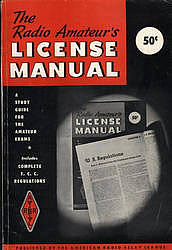The Early 1960s
 |
The 1964 edition of the ARRL License Manual devoted only
3-1/2 pages to the 34-item "question pool" for the Novice license.
|
1960s: FCC permitted hams to hold both the Novice and Technician simultaneously. These hams had two call signs. They would use the appropriate call sign when using the corresponding privilege. The Novice was a one-year non-renewal license.
About 1960: FCC stopped issuing WV# Novice call signs and went to WN call signs.
1962: FCC denied petition for rulemaking which sought to give Technicians full privileges on 10 meters. FCC reaffirmed its policy that Technicians are VHF/UHF experimenters and not communicators. The next step for Novices is to upgrade to General and not to Technician.
A new magazine called VHF Horizons started publishing. The magazine was devoted to 50mc and above. Its editorial policy called for the FFC to change its policy and let Technicians become communicators, not just experimenters. While Technicians liked the magazine and its editorial policy, higher class license holders did not. Generals, Advanced and Extras sided with FCC policy and favored Novices upgrading to General and bypassing Technician.
1963: CB’ers outnumber hams.
In 1964: VHF Horizons ceased publication due to insolvency. There were over 250,000 hams in the U.S. 60,000 of them were members of the American Radio Relay League. FCC proposed licensing fees of between $5 to $10. Notarization in which applicants for both ham and CB licenses swore they were providing accurate information was dropped. “WB” call signs had started to be issued by the FCC in the second and sixth call districts.
Mid-1960s: The “WA” prefix was exhausted in the second, fourth and sixth call districts. FCC started reissuing vacant “WA” call signs. |